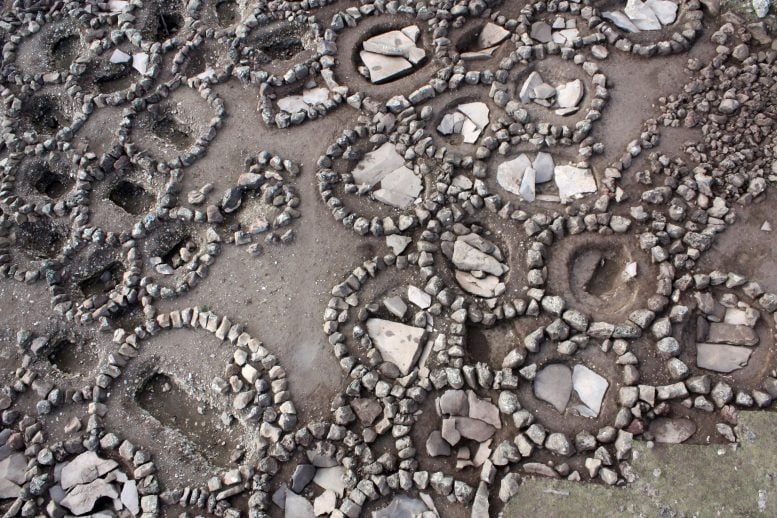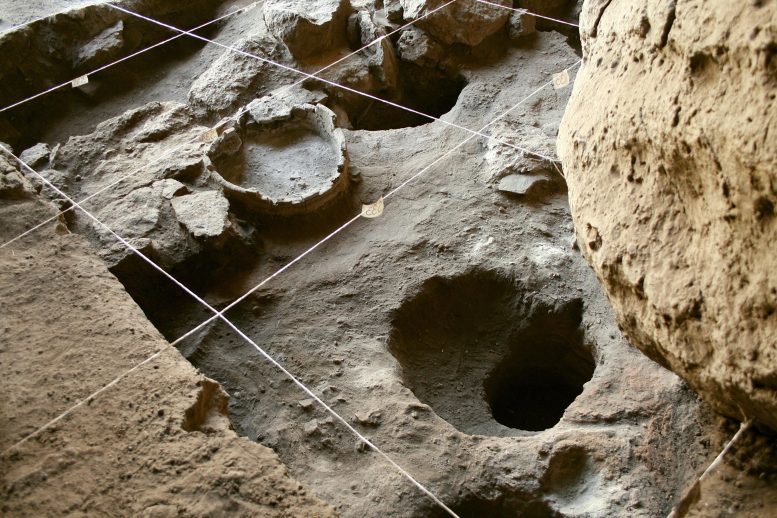
Vast paleogenetic study reveals insights on migration patterns, the expansion of farming, and language development from the Caucasus over western Asia and Southern Europe from the early Copper Age until the late middle ages.
In a trio of scientific papers, published simultaneously in the journal Science, researchers report a massive effort of genome-wide sequencing from 727 distinct ancient individuals with which it was possible to test longstanding archaeological, genetic, and linguistic hypotheses. They present a systematic picture of the interlinked histories of peoples across the Southern Arc Region from the origins of agriculture, to late medieval times. The scientists include Ron Pinhasi from the Department of Evolutionary Anthropology and Human Evolution and Archaeological Sciences (HEAS) at the University of Vienna and Songül Alpaslan-Roodenberg from the University of Vienna and Harvard University, Iosif Lazaridis and David Reich at Harvard University—together with 202 co-authors.
In the first paper, the international research team investigated the homeland and the spread of Anatolian and Indo-European languages. The genetic results indicate that the homeland of the Indo-Anatolian language family was in West Asia, with only secondary dispersals of non-Anatolian Indo-Europeans from the Eurasian steppe. In the first stage, around 7,000-5,000 years ago, people with ancestry from the Caucasus moved west into Anatolia and north into the steppe. Some of these people may have spoken ancestral forms of Anatolian and Indo-European Languages.
Genetic Evidence of Yamnaya Influence Across Europe and West Asia
All spoken Indo-European languages (e.g., Greek, Armenian, and Sanskrit) can be traced back to Yamnaya steppe herders, with Caucasus hunter-gatherer and Eastern hunter-gatherer ancestry, who initiated a chain of migrations across Eurasia around 5,000 years ago. Their southern expansions into the Balkans and Greece and east across the Caucasus into Armenia left a trace in the DNA of the Bronze Age people of the region.
As they expanded, descendants of the Yamnaya herders mixed differentially with the local populations. The emergence of Greek, Paleo-Balkan, and Albanian (Indo-European) languages in Southeastern Europe and the Armenian language in West Asia, formed out of Indo-European-speaking migrants from the steppe interacting with local people, and can be traced by different forms of genetic evidence. In Southeastern Europe, the Yamnaya impact was profound and people of practically full Yamnaya ancestry came just after the beginning of the Yamnaya migrations.

Some of the most remarkable results are found in the core region of the Southern Arc, Anatolia, where the large-scale data paints a rich picture of change—and lack of change—over time.
The results reveal that in contrast to the Balkans and the Caucasus, Anatolia was hardly impacted by the Yamnaya migrations. No link to the steppe can be established for the speakers of Anatolian languages (e.g. Hittite, Luwian) due to the absence of Eastern hunter-gatherer ancestry in Anatolia, differing from all other regions where Indo-European languages were spoken.
In contrast to Anatolia’s surprising impermeability to steppe migrations, the southern Caucasus was affected multiple times including prior to the Yamnaya migrations. “I did not expect to find out that the Areni 1 Chalcolithic individuals, who were recovered 15 years ago in the excavation I co-led, would derive ancestry from gene flow from the north to parts of the southern Caucasus more than 1,000 years prior to the expansion of the Yamnaya, and that this northern influence would disappear in the region before reappearing a couple of millennia later. This shows that there is a lot more to be discovered through new excavations and fieldwork in the eastern parts of Western Asia” says Ron Pinhasi.
“Anatolia was home to diverse populations descended from both local hunter-gatherers and eastern populations of the Caucasus, Mesopotamia, and the Levant,” says Songül Alpaslan-Roodenberg. “The people of the Marmara region and of Southeastern Anatolia, of the Black Sea, and the Aegean region all had variations of the same kinds of ancestry,” continues Alpaslan-Roodenberg.
First Farming Societies and Their Interactions
The second paper seeks to understand how the world’s earliest Neolithic populations were formed around 12,000 years ago. “The genetic results lend support to a scenario of a web of pan-regional contacts between early farming communities. They also provide new evidence that the Neolithic transition was a complex process that did not occur just in one core region, but across Anatolia and the Near East” says Ron Pinhasi.
It provides the first ancient DNA data for Pre-Pottery Neolithic farmers from the Tigris side of northern Mesopotamia—both in eastern Turkey and in northern Iraq—a prime region of the origins of agriculture. It also presents the first ancient DNA from Pre-Pottery farmers from the island of Cyprus, which witnessed the earliest maritime expansion of farmers from the eastern Mediterranean. Furthermore, it presents new data for early Neolithic farmers from the Northwest Zagros, along with the first data from Neolithic Armenia. By filling these gaps, the authors could study the genetic history of these societies for which archaeological research documented complex economic and cultural interactions but could not trace mating systems and interactions which do not leave visible material traces. Results reveal admixture of pre-Neolithic sources related to Anatolian, Caucasus, and Levantine hunter-gatherers. The study also shows that these early farming cultures formed a continuum of ancestry mirroring the geography of West Asia. Additionally, the results chart at least two pulses of migration from the Fertile Crescent heartland to the early farmers of Anatolia.
The Historic Period
The third paper shows how polities of the ancient Mediterranean world preserved contrasts of ancestry since the Bronze Age but were linked by migration. The results reveal that the ancestry of people who lived around Rome in the Imperial period was almost identical to that of Roman/Byzantine individuals from Anatolia in both their mean and pattern of variation, while Italians prior to the Imperial period had a very different distribution. This indicates that the Roman Empire in both its shorter-lived western part and the longer-lasting eastern part centered on Anatolia had a diverse but similar population plausibly drawn to a substantial extent from Anatolian pre-Imperial sources.
“These results are really surprising as in a Science paper that I co-led in 2019, on the genetic ancestry of individuals from Ancient Rome, we found a cosmopolitan pattern that we thought was unique to Rome. Now we see other regions of the Roman Empire were also just as cosmopolitan as Rome itself,” says Ron Pinhasi.
References:
- “The genetic history of the Southern Arc: A bridge between West Asia and Europe” by Iosif Lazaridis, Songül Alpaslan-Roodenberg, Ayse Acar, Aysen Açikkol, Anagnostis Agelarakis, Levon Aghikyan, Ugur Akyüz, Desislava Andreeva, Gojko Andrijaševic, Dragana Antonovic, Ian Armit, Alper Atmaca, Pavel Avetisyan, Ahmet Ihsan Aytek, Krum Bacvarov, Ruben Badalyan, Stefan Bakardzhiev, Jacqueline Balen, Lorenc Bejko, Rebecca Bernardos, Andreas Bertsatos, Hanifi Biber, Ahmet Bilir, Mario Bodružic, Michelle Bonogofsky, Clive Bonsall, Dušan Boric, Nikola Borovinic, Guillermo Bravo Morante, Katharina Buttinger, Kim Callan, Francesca Candilio, Mario Caric, Olivia Cheronet, Stefan Chohadzhiev, Maria-Eleni Chovalopoulou, Stella Chryssoulaki, Ion Ciobanu, Natalija Condic, Mihai Constantinescu, Emanuela Cristiani, Brendan J. Culleton, Elizabeth Curtis, Jack Davis, Tatiana I. Demcenco, Valentin Dergachev, Zafer Derin, Sylvia Deskaj, Seda Devejyan, Vojislav Djordjevic, Kellie Sara Duffett Carlson, Laurie R. Eccles, Nedko Elenski, Atilla Engin, Nihat Erdogan, Sabiha Erir-Pazarci, Daniel M. Fernandes, Matthew Ferry, Suzanne Freilich, Alin Frînculeasa, Michael L. Galaty, Beatriz Gamarra, Boris Gasparyan, Bisserka Gaydarska, Elif Genç, Timur Gültekin, Serkan Gündüz, Tamás Hajdu, Volker Heyd, Suren Hobosyan, Nelli Hovhannisyan, Iliya Iliev, Lora Iliev, Stanislav Iliev, Ilkay Ivgin, Ivor Jankovic, Lence Jovanova, Panagiotis Karkanas, Berna Kavaz-Kindigili, Esra Hilal Kaya, Denise Keating, Douglas J. Kennett, Seda Deniz Kesici, Anahit Khudaverdyan, Krisztián Kiss, Sinan Kiliç, Paul Klostermann, Sinem Kostak Boca Negra Valdes, Saša Kovacevic, Marta Krenz-Niedbala, Maja Krznaric Škrivanko, Rovena Kurti, Pasko Kuzman, Ann Marie Lawson, Catalin Lazar, Krassimir Leshtakov, Thomas E. Levy, Ioannis Liritzis, Kirsi O. Lorentz, Sylwia Lukasik, Matthew Mah, Swapan Mallick, Kirsten Mandl, Kristine Martirosyan-Olshansky, Roger Matthews, Wendy Matthews, Kathleen McSweeney, Varduhi Melikyan, Adam Micco, Megan Michel, Lidija Milašinovic, Alissa Mittnik, Janet M. Monge, Georgi Nekhrizov, Rebecca Nicholls, Alexey G. Nikitin, Vassil Nikolov, Mario Novak, Iñigo Olalde, Jonas Oppenheimer, Anna Osterholtz, Celal Özdemir, Kadir Toykan Özdogan, Nurettin Öztürk, Nikos Papadimitriou, Niki Papakonstantinou, Anastasia Papathanasiou, Lujana Paraman, Evgeny G. Paskary, Nick Patterson, Ilian Petrakiev, Levon Petrosyan, Vanya Petrova, Anna Philippa-Touchais, Ashot Piliposyan, Nada Pocuca Kuzman, Hrvoje Potrebica, Bianca Preda-Balanica, Zrinka Premužic, T. Douglas Price, Lijun Qiu, Siniša Radovic, Kamal Raeuf Aziz, Petra Rajic Šikanjic, Kamal Rasheed Raheem, Sergei Razumov, Amy Richardson, Jacob Roodenberg, Rudenc Ruka, Victoria Russeva, Mustafa Sahin, Aysegül Sarbak, Emre Savas, Constanze Schattke, Lynne Schepartz, Tayfun Selçuk, Ayla Sevim-Erol, Michel Shamoon-Pour, Henry M. Shephard, Athanasios Sideris, Angela Simalcsik, Hakob Simonyan, Vitalij Sinika, Kendra Sirak, Ghenadie Sirbu, Mario Šlaus, Andrei Soficaru, Bilal Sögüt, Arkadiusz Soltysiak, Çilem Sönmez-Sözer, Maria Stathi, Martin Steskal, Kristin Stewardson, Sharon Stocker, Fadime Suata-Alpaslan, Alexander Suvorov, Anna Szécsényi-Nagy, Tamás Szeniczey, Nikolai Telnov, Strahil Temov, Nadezhda Todorova, Ulsi Tota, Gilles Touchais, Sevi Triantaphyllou, Atila Türker, Marina Ugarkovic, Todor Valchev, Fanica Veljanovska, Zlatko Videvski, Cristian Virag, Anna Wagner, Sam Walsh, Piotr Wlodarczak, J. Noah Workman, Aram Yardumian, Evgenii Yarovoy, Alper Yener Yavuz, Hakan Yilmaz, Fatma Zalzala, Anna Zettl, Zhao Zhang, Rafet Çavusoglu, Nadin Rohland, Ron Pinhasi and David Reich, 26 August 2022, Science.
DOI: 10.1126/science.abm4247 - “A genetic probe into the ancient and medieval history of Southern Europe and West Asia” by David Reich, et al., 25 August 2022, Science.
DOI: 10.1126/science.abq0755 - “Ancient DNA from Mesopotamia suggests distinct Pre-Pottery and Pottery Neolithic migrations into Anatolia” by David Reich, et al., 25 August 2022, Science.
DOI: 10.1126/science.abq0762
Never miss a breakthrough: Join the SciTechDaily newsletter.